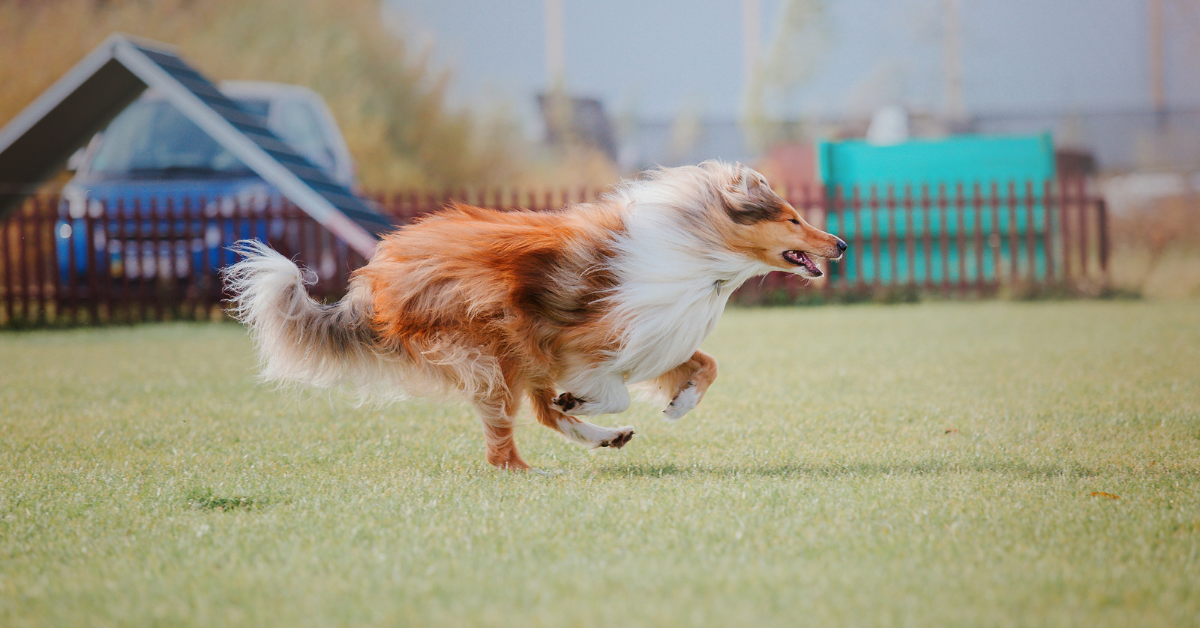Why Do Dogs Get The Zoomies?

Have you ever noticed your dog get a sudden burst of energy, running around and around the backyard or house? Running into the room at full speed, he circles the coffee table and then speeds off down the hallway, thundering through the doorway and back again. Your first thought might be to wonder what he was up to, whether he saw another dog or if something set him off. It was simply a case of the dog zoomies.
This typical and amusing behavior is often called the "zoomies." But why do dogs get the zoomies? This blog explores the reasons behind this energetic outburst, what it means for your pet, and how you can engage with and manage this behavior.
Understanding the Zoomies: Frenetic Random Activity Periods (FRAPs)
The zoomies, scientifically known as Frenetic Random Activity Periods (FRAPs), are natural and normal dog behavior. These sudden bursts of energy often see dogs darting around at full speed, sometimes in circles or zigzags, with wide eyes and a wagging tail. This behavior is ubiquitous in puppies and young dogs, though adult dogs can also get the zoomies.
Frequent Causes of Dog Zoomies
Dogs get the zoomies for various reasons. Some of the most frequent causes include:
- Release of Pent-Up Energy: Dogs, especially puppies and younger dogs, tend to have a lot of energy that needs to be released. Zoomies often occur after long periods of inactivity, such as after being in a crate, following a nap, or in the evening after a day of moderate activity.
- Excitement and Playfulness: Dogs frequently get the zoomies when feeling particularly happy or excited. This could be after a bath, during or after a play session, or when they see someone they love.
- Stress and Nervous Energy: Zoomies can also be a way for dogs to relieve stress or nervous energy. After a stressful situation, like a visit to the vet or an encounter with a new dog, dogs might engage in a burst of energy to alleviate built-up tension.
- Environmental Stimuli: Changes in the environment, like a new toy, a change in weather, or the presence of other dogs, can also trigger zoomies. Certain breeds are more prone to this behavior due to their high energy levels.
Zoomies in Puppies and Younger Dogs
Puppy zoomies are a well-known phenomenon among dog owners. Puppies have a tremendous amount of energy and fewer ways to release it. This results in frequent zoomies, a sign of a healthy, active pup. Younger dogs are naturally more energetic and curious, leading to more frequent zoomies than older dogs.
Role of Physical Exercise and Mental Stimulation
To manage and understand the zoomies, it’s essential to consider the role of exercise and mental stimulation in a dog’s life. Many dogs get zoomies due to excess energy that needs an outlet.
Physical Exercise

Dogs of all ages need regular physical exercise. Ensuring that your dog gets enough exercise can help reduce the frequency of zoomies. Activities that can help expend your dog's energy include:
- Walking
- Running
- Playing fetch in the yard
Fetch toys are an excellent way to give your dog physical exercise. Playing fetch can help your dog burn off energy in a controlled manner, which may reduce the occurrence of zoomies. Fetch toys come in various forms from Chuckit! Amphibious boomerangs to Rope Fetch Dog Toys that can be used in parks or backyards.
Mental Stimulation

Mental stimulation is just as important as physical exercise. Dogs need to engage their minds to stay happy and healthy. Training sessions, puzzle toys, and interactive games can provide mental challenges that help reduce pent-up energy.
Tug toys provide an excellent outlet for dogs experiencing zoomies, offering a focused way to expend excess energy. By engaging in tug-of-war, dogs can satisfy their instinctual urges and improve their mental stimulation, which helps to calm them down and redirect their frantic energy constructively.
Safe Spaces and Zoomies Management
Managing the zoomies involves creating a safe environment for your dog to express this natural behavior without causing harm to themselves or damage to your home.
Creating a Safe Space
It’s important to ensure that your home or yard is safe for your dog to run around during their zoomies. Clear away any obstacles that could cause injury, such as sharp objects or fragile items. If your dog gets the zoomies indoors, watch out for slippery floors, coffee tables, and other furniture that might pose a risk.
Redirecting Energy
If zoomies become frequent or problematic, redirecting your dog's energy through play sessions or training can help. Engage your dog in activities that challenge them both physically and mentally, reducing the likelihood of sudden bursts of energy.
Training and Behavior Management
Training your dog to respond to commands even during their most excited states can be beneficial. Certified professional dog trainers and certified applied animal behaviorists can provide guidance on managing zoomies through training techniques that encourage self-control and obedience.
When to Be Concerned
While zoomies are generally a sign of a healthy, happy dog, there are instances when you should be cautious. If your dog has constant zoomies, it may be a sign that they are not getting enough exercise or mental stimulation. Additionally, if your dog’s zoomies seem triggered by stress or anxiety, it’s worth consulting with a veterinarian or a behaviorist to address any underlying issues.
Normal Dog Behavior vs. Signs of Stress
Most dogs will have zoomies occasionally, and it’s usually a regular part of their behavior. However, it might be worth exploring further if you notice signs of stress or other concerning behaviors accompanying the zoomies. Behavior could indicate that your dog is experiencing stress. This may include:
- Excessive panting
- Hiding
- Destructive actions.
Embracing the Zoomies
Dog zoomies are a natural and typical behavior that serves various purposes, from releasing pent-up energy to expressing happiness. Understanding why dogs get the zoomies can help you manage and embrace this behavior safely and enjoyably. Zoomies are a sign of a happy and healthy dog, so enjoy these playful moments with your furry companion!
For the best in pet supplies, consider Petmate. Petmate offers a range of products from fetch toys to tag toys to keep your dog happy and healthy. Visit us today to find the perfect toys and accessories for your pooch.
Previous article

Next article

Related posts
View all-

How to Keep Your Pet Calm During Thanksgiving
Thanksgiving is a time for family, friends, and food, but for our pets, the holiday can be overwhelming. The sudden change in routine, unfamiliar faces and scents, and increased noise can trigger significant stress. Understanding why your pet might feel anxious is the first step toward creating a peaceful holiday experience for everyone, including your furry family members. This guide offers calming tips for pets and practical solutions to ensure your dog or cat feels safe and secure during the festivities.
Read Article -

Top Travel Essentials for Pets This Holiday Season
Holiday travel often means bringing the whole family along, and for many of us, that includes our furry companions. Preparing for holiday pet travel is about more than just packing a bag; it's about ensuring your pet's safety, comfort, and happiness from the moment you leave home until you return. A little planning helps reduce stress for both you and your pet, making the journey a positive experience for everyone involved.
Read Article -

Best Leashes and Collars for Daily Walks: A Pet Parent’s Guide
A daily walk with your dog isn't just a chore—it's a chance to bond, explore, and stay active together. The right leash and collar can make every walk safer and more enjoyable for both of you. With numerous styles and materials available, it's essential to find gear that suits your dog's needs and your lifestyle.
Read Article



